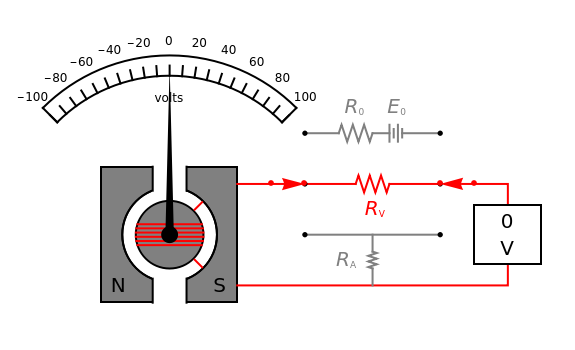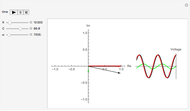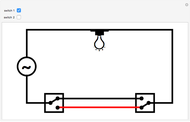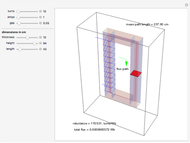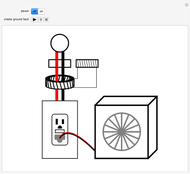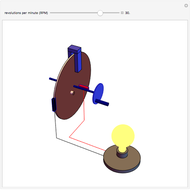Galvanometer as a DC Multimeter

Requires a Wolfram Notebook System
Interact on desktop, mobile and cloud with the free Wolfram Player or other Wolfram Language products.
In a D'Arsonval galvanometer, a disk wound with many turns of fine wire can rotate in the field of a permanent magnet, its deflection proportional to the current through the wire. A coil spring (not shown) provides a restoring torque to the disk. As part of an appropriate circuit, the galvanometer can function as a DC multimeter, measuring the voltage, current, or resistance of a connected circuit element, shown as a black rectangle. Depending on the mode selected—voltmeter, ammeter, or ohmmeter—the branch of the circuit shown in red is operative. As an illustration, let the resistance of the galvanometer  equal 20 Ω, while
equal 20 Ω, while  and
and  . This will enable the galvanometer to read voltages in the range -100 to 100 V and currents in the range -10 to 10 A. With an appropriate choice of
. This will enable the galvanometer to read voltages in the range -100 to 100 V and currents in the range -10 to 10 A. With an appropriate choice of  and
and  , resistances in the range 5 to 1000 Ω can likewise be measured. Note that the current through the galvanometer is inversely proportional to the resistance, thus the ohmmeter scale is linear in
, resistances in the range 5 to 1000 Ω can likewise be measured. Note that the current through the galvanometer is inversely proportional to the resistance, thus the ohmmeter scale is linear in  .
.
Contributed by: S. M. Blinder (October 2008)
With improvements suggested by Harold Thimbleby
Open content licensed under CC BY-NC-SA
Snapshots
Details
detailSectionParagraphPermanent Citation
"Galvanometer as a DC Multimeter"
http://demonstrations.wolfram.com/GalvanometerAsADCMultimeter/
Wolfram Demonstrations Project
Published: October 13 2008
